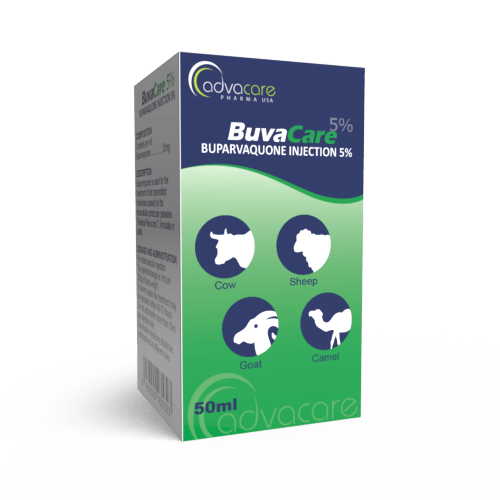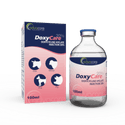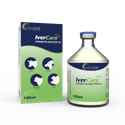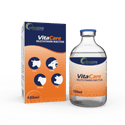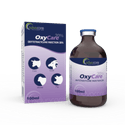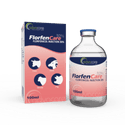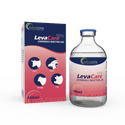- Home›
- Veterinary Pharmaceuticals›
- Veterinary Injections›
- Veterinary Liquid Injections›
- Buparvaquone Injection
Buparvaquone Injection
Dosage
Packaging
What is Buparvaquone?
Active Ingredients: Buparvaquone
Buparvaquone Injection is a drug used to treat and prevent tick-transmitted theileriosis in cows. It is indicated for infections caused by the parasite Theileria parva, including East Coast fever, corridor disease, and Zimbabwe theileriosis. It is also effective against tropical theileriosis caused by T. annulate. This drug is also indicated for the treatment of Babesiosis.
Buparvaquone is effective during the schizont and piroplasm stages of the disease. It also can be used during the incubation period.
Buparvaquone is classified as a second-generation hydroxynaphthoquinone. It is an antiprotozoal agent that is related to the drug atovaquone. Though the exact mechanism of action has not been identified, it is thought to work by blocking the respiratory chain within the parasite.
It is important to note that this drug is for veterinary purposes only. It should be prescribed by a veterinary doctor or animal care specialist for an animal.
Buparvaquone Injection is produced by AdvaCare Pharma, a pharmaceutical company specializing in global exportation. This medication is part of our comprehensive catalog of veterinary supplies, which are available for distribution. Our manufacturing factories are located in China, India, and the USA.
Why are we a trusted Buparvaquone manufacturer?
Buparvaquone Injection is manufactured and globally distributed by AdvaCare Pharma, a leading manufacturer of veterinary injections in the pharmaceutical industry. We have been committed to distributing high-quality, GMP-certified veterinary medications for the global market over the past 20 years. As a top Buparvaquone manufacturer, we ensure that all of our 100+ veterinary injections surpass our distributors' requirements by conducting routine internal and third-party facility audits.
Uses
What is Buparvaquone used for?
It is used to treat or prevent tick-transmitted theileriosis caused by Theileria parva or T. annulate, including the diseases:
- east coast fever
- corridor disease
- Zimbabwe theileriosis
- tropical theileriosis
It is effective against both the schizont and piroplasm stages of the parasite.
What animals can be treated with Buparvaquone Injection?
This medicine is recommended for use in cows.
How is Buparvaquone Injection used?
This medication has been manufactured as a liquid, which is packaged in a vial. It is intended to be administered by intramuscular injection. Before administering the drug, the animal’s coat should be cleaned to reduce the chances of contamination.
How can Buparvaquone help in the treatment of Theileriosis?
Theileriosis are tick borne diseases caused by protozoan parasites of the Theileria genus. There are many Theileria found in the tropical and subtropical regions of the world, and this drug is used mostly there. T.parva and T.annulata affect the cattle and cause high mortality. The control of this disease includes prevention of tick infestation and vaccination in some areas. When the disease occurs, Buparvaquone is used for the treatment process.
The protozoan parasite completes the life cycle in the white blood cells and red blood cells in mammalians. The infective stage of the parasite is the sporozoite and it is transmitted by the saliva of the infected ticks as they feed. First, the sporozoite infects the white blood cells, and in a few days, it develops into a schizont. Fewer pathogenic parasite species invade the red blood cells.
This drug can reduce the severity of the clinical signs. The signs vary from inapparent/mild to severe and fatal. Buparvaquone can reduce fever in animals, which might rise up to 107°F (42°C). It also reduces and alleviates lymph node swelling. Animals can easily normalize their appetite, and the application of this drug leads to normal body weight. When detected and treated on time, this drug can prevent pulmonary edema and hyperemia.
How does Buparvaquone function?
This drug is administered through injection intramuscularly. It is then rapidly absorbed into the bloodstream and distributed to various tissues and organs. The distribution depends on factors like blood flow and tissue composition. The drug is metabolized in the liver, and it is processed there. This drug is eliminated through urine and bile. The excretion is affected by the animal’s age, weight, and health status. Other drugs that are present in the animal’s bloodstream may affect its elimination.
Is Buparvaquone enough for treating Theileriosis?
Buparvaquone directly affects the treatment of Theileriosis in cattle. However, it should be accompanied by anti-inflammatory drugs and antidiuretics in cases of pulmonary edema. The treatment is effective in the early stages of clinical signs, but it might require more than one dose. In advanced stages, the treatment is demanding. It needs more dosages, and the treatment process can get complicated if there is lymphoid and hematopoietic tissue destruction.
Cattle that are often treated with this drug can become resistant to it. The dosages should be provided by the veterinarian and followed accordingly.
In locations where this disease is prevalent, spraying and dipping the animals in acaricides can prevent the occurrence. This should be done in previously determined time intervals. Pyrethroids can be used for the dipping and prevention of the disease. Vaccination against T.parva can also help in the prevention. The vaccines should be given with a single dose of long-acting oxytetracycline simultaneously.
Can Buparvaquone be used in pregnant or lactating animals?
This drug is effective against bovine theileriosis, but its efficiency can be reduced between 6 and 8 months of pregnancy. The veterinarian should decide whether this drug is harmless in pregnant or lactating animals. Professionals should outweigh the risks and benefits for pregnant and lactating animals. The safety mainly depends on the stage of pregnancy or lactation.
Can Buparvaquone be used preventively?
The control of this theileriosis includes prevention of tick infestation and vaccination in tropical and subtropical areas. Additionally, this drug can prevent pulmonary edema and hyperemia. There are other methods for preventing the diseases. This includes spraying and dipping the animals in acaricides. It will prevent the occurrence. Veterinarians and veterinary technicians should perform this in previously determined time intervals. Pyrethroids are also useful in theileriosis prevention. Animals should be dipped in pyrethroids to avoid the occurrence of the disease. Vaccination in tropical and subtropical regions is another way of preventing the disease.
How quickly does Buparvaquone take effect?
Most of the animals have health improvements after 2-3 days after administration. The recovery rate depends on the clinical stage. Veterinarians should decide whether one dose of Buparvaquone is enough for treatment. Very often, the treatment includes other drugs like diuretics and anti-inflammatory drugs.
Is Buparvaquone injection used only on cattle?
No, Buparvaquone can be used for treating Babesia equi in horses. This drug can lead to fast recovery in horses. This disease is caused by Theileria (Babesia) equi, and it is prevalent in South and Central America, Africa, the Middle East, and Eastern and Southern Europe. The drug can reduce the following clinical signs:
- fever
- lack of appetite
- weight loss
- anemia
- jaundice
- exercise intolerance/weakness
- difficulty breathing
- swollen abdomen
How should Buparvaquone Injection be stored?
This medication should be stored in a dark, dry location between 15-25°C. The vial should be sealed tightly when not used.
What are the withdrawal times for Buparvaquone Injection?
The withdrawal period for meat is 42 days. For milk, the withdrawal period is 48 hours. The withdrawal period depends on the geolocation. Each country has its own withdrawal period.
Check your country and state regulations before applying this drug.
Dosage
How much Buparvaquone should be given to cattle?
The usual dose is 1ml per 20kg of body weight, given as a single dose. Treatment may be repeated 48-72 hours later if necessary. This injection is typically administered into the neck muscles.
The injection should be administered intramuscularly. The area of injection administration should be free of major blood vessels and nerves. The fur should be clipped and shaved. This will prevent contamination and will lead to better visualization.
The veterinarian should wash the hands before administering the injection. The equipment, including syringes and needles, should be sterile and free from contaminants. Avoid touching the needle directly with your hands. The field of administration should be sterile and veterinarians should minimize the time between preparation and administration.
The dose depends on the disease stage and the animal’s body weight. It should be determined by a veterinarian, but usually, only one dose is enough for the treatment process.
Refer to a veterinary doctor or pharmacist for guidelines on dosage.
Side Effects
As with all pharmaceuticals, some unwanted effects can occur from the use of Buparvaquone Injection.
Localized reactions and pain at the injection site are common side effects. Serious side effects may include signs of an allergic reaction (skin rash, fever, facial swelling, or difficulty breathing). If you notice any side effects contact a veterinarian as soon as possible. Additional therapy might be needed in cases of adverse effects and behavior.
For a comprehensive list of all possible side effects of this medication, consult a veterinarian.
Precautions
Do NOT use Buparvaquone Injection in animals that: • have a known allergy or hypersensitivity to any of the ingredients.
Due to the immunosuppressive effects of this medicine, vaccines should be delayed until after the animal has fully recovered from illness.
Do not administer this injection through the subcutaneous or intravenous routes.
Keep this drug out of reach of children and animals.
Why is Buparvaquone Injection used in cattle?
Buparvaquone Injection is primarily employed for the treatment of parasitic infections in cattle. The specific common uses of Buparvaquone Injection include the treatment of the following diseases:
- East Coast fever
- Corridor disease
- Zimbabwe theileriosis
- Tropical theileriosis
Cattle Parasitic Infections
This drug can help in treating parasitic infections in cattle. It is mostly used for treating theileriosis.

You might be interested in...
Why AdvaCare Pharma?
As an industry leader, we are aware of our responsibility to provide affordable and sustainable solutions to improve healthcare worldwide.


